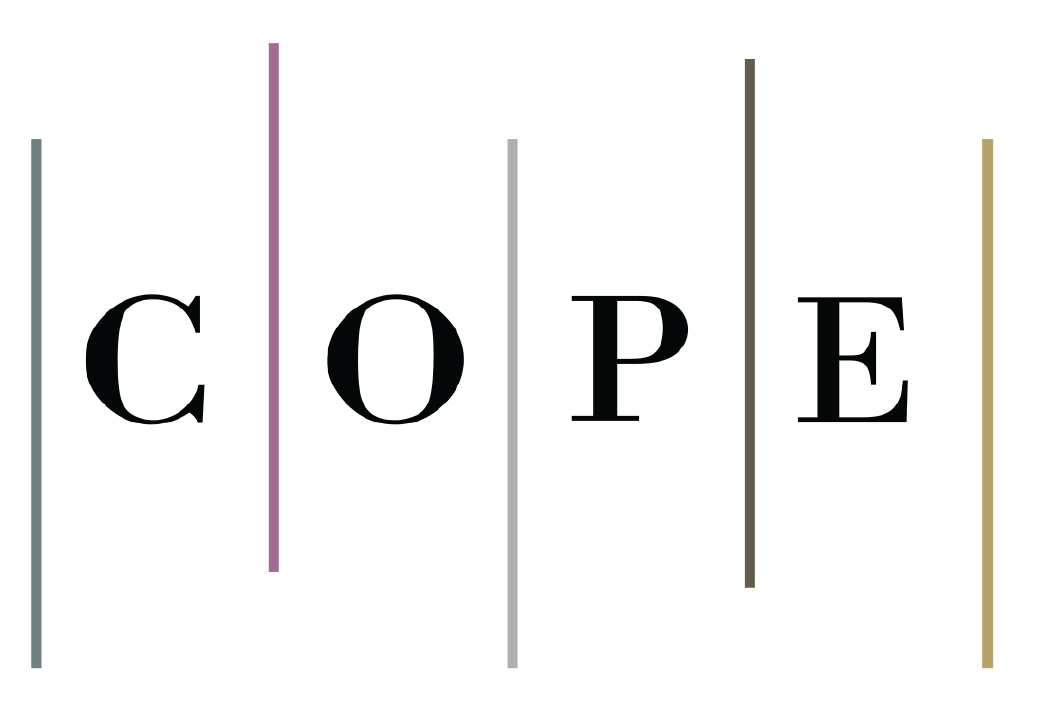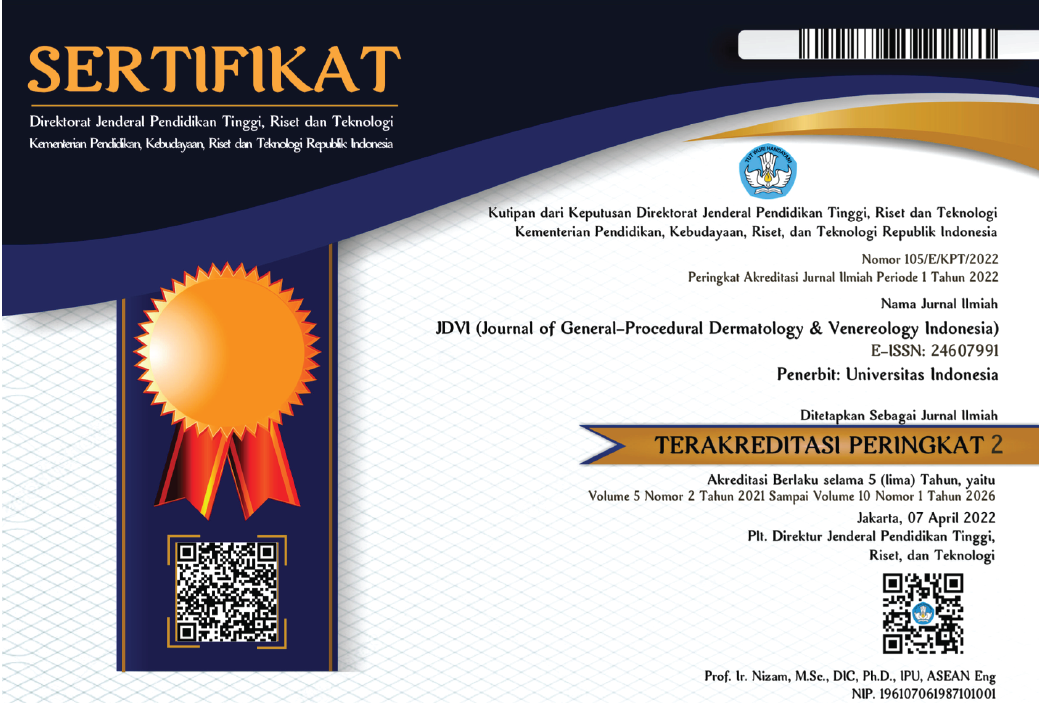An overview of risk factors for androgenetic alopecia among women at Pasar Ambacang, Kuranji, Padang
Abstract
Background: Androgenetic alopecia (AGA) is a patterned hair loss due to chronic and progressive miniaturization of hair follicles. Hair represents femininity and self-confidence in women. Therefore, AGA may affect the quality of life and psychology in women. This study aims to describe the risk factors for AGA in women living in Pasar Ambacang Sub-district, Kuranji District, Padang City.
Method: This was a descriptive, cross-sectional study that included 40 women with AGA. Interviews with subjects were conducted. This study was approved by the Health Research Ethics Committee at Universitas Andalas (252/UN.16.2/KEPK-FK/2021)
Results: AGA was mostly found on patients aged >65 years old (32.5%), married with childbearing (87.5%), overweight (32-5%), had a family history of AGA from the patient’s father (57.5%,) and a family history of AGA from the patient’s mother (75%). According to their medical history, respondents mostly had no hypertension (65%), type-2 diabetes mellitus (DM) (92.5%), and polycystic ovarian syndrome (PCOS) (100%). Most respondents had menarche at (95%), regular menstrual cycles (95%), and were non- menopausal (67.5%). The most common type of AGA was the type I Ludwig Classification (67.5%).
Conclusion: Among women, AGA mostly occurred in patients with the following conditions: aged >65 years old, overweight, married with childbearing, had menarche at old, regular menstrual cycles, non- menopausal, and paternal or maternal history of AGA. AGA risk factors, such as hypertension, DM, and PCOS, were slightly found. The most common type of AGA was the type I Ludwig Classification.
References
- Kabir Y, Goh C. Androgenetic alopecia: Update on epidemiology, pathophysiology, and treatment. Journal of the Egyptian Women's Dermatologic Society. 2013;10(3):107–16.
- Esen SK, Kucukunal NA, Kivanc AI, Aksu CA. Frequency, severity and related factors of androgenetic alopecia in dermatology outpatient clinic: Hospital-based cross- sectional study in Turkey. An Bras Dermatol. 2017;92(1):35–40.
- Legiawati L. Jenis kerontokan rambut dan kebotakan pasien Poliklinik Kulit dan Kelamin RSUPN Dr. Cipto Mangunkusumo tahun 2009-2011 (in Indonesian). Media Dermato- venerologica Indonesiana. 2013;40(4):159–63.
- Pravitasari DN, Sentyaningrum T. The profile of new androgenetic alopecia patients at dermatovenereology outpatient clinic of Dr. Soetomo Hospital Surabaya in 2009-2011. The 3 rd International Symposium of Public Health (The 3rd ISoPH); 2019.
- Davis DS, Callender VD. Review of quality of life studies in women with alopecia. Int J Women’s Dermatology. 2018;4(1):18–22.
- Shilpashree P, Clarify S, Jaiswal AK, Shashidhar T. Impact of female pattern hair loss on the quality of life of patients. Journal of Pakistan Association of Dermatologists. 2016;26(4):347–52.
- Price VH. Androgenetic alopecia in women. J Investig Dermatol Symp Proc. 2003;8(1):24–7.
- Fabbrocini G, Cantelli M, Masarà A, Annunziata MC, Marasca C, Cacciapuoti S. Female pattern hair loss: A clinical, pathophysiologic, and therapeutic review. Int J Womens Dermatol. 2018;4(4):203–11.
- Ramos PM. Female pattern hair loss: A clinical and pathophysiological review. An Bras Dermatol. 2015;90(4):529–43.
- Laporan Tahunan Puskesmas Pasar Ambacang Tahun 2021. Padang: Puskesmas Pasar Ambacang; 2021.
- Dhariwala MY, Ravikumar P. An overview of herbal alternatives in androgenetic alopecia. J. Cosmet Dermatol. 2019:18:966–75.
- Blumeyer A, Tosti A, Finner A, Marmol V, Trakatelli M, Reygagne P. S 1 guideline for diagnostic evaluation in androgenetic alopecia in men, women and adolescents. Br J Dermatol. 2010;164(1):5–15.
- Patel M, Perez A, Sinclair R. An overview of female pattern hair loss. Expert Rev Dermatol. 2011;6(3):317–27.
- Birch MP, Messenger JF, Messenger AG. Hair density, hair diameter and the prevalence of female pattern hair loss. Br J Dermatol. 2010;297–304.
- Norwood OT, Hair L, Clinic T, City O. Incidence of female androgenetic alopecia (female pattern alopecia). Dermatol Surg. 2010;53–4.
- Chiang LHN, Sue SC. Development of human geography in Taiwan in the last decade. Japanese J Hum Geogr. 2006;58(6):25–39.
- Wahyuni RS, Suarni E, Pamudji R. Hubungan efluvium dengan pengguna jilbab di Fakultas Kedokteran Universitas Muhammadiyah Palembang. Medical Scientific Journal. 2020;1:33-47.
- Kutlu Ö, Metin A. Systemic dexpanthenol as a novel treatment for female pattern hair loss. J Cosmet Dermatol. 2021;20(4):1325–30.
- Yi Y, Li X, Jia J, et al. Effect of behavioral factors on severity of female pattern hair loss: An ordinal logistic regression analysis. Int J Med Sci. 2020;17(11):1584–8.
- Mu Z, Yeung WJJ. Internal migration, marriage timing and assortative mating: A mixed-method study in China. Journal of Ethnic Migration Studies. 2020;46(14):2914–36.
- Piérard-franchimont C, Piérard GE. Alterations in hair follicle dynamics in women. Biomed Res Int. 2013; 2013:957432.
- Singal A, Sonthalia S, Verma P. Female pattern hair loss. Indian J Dermatol Venereol Leprol. 2013;79(5):626–40.
- Carmina E, Azziz R, Bergfeld W, et al. Female pattern hair loss and androgen excess: A report from the multidisciplinary androgen excess and PCOS committee. J Clin Endocrinol Metab. 2019;104(7):2875–91.
- Odhaib SA, Al Hamdi K, Mansour AA. Is there any association between clinical and biochemical hyperandrogenism in women with female pattern hair loss? Cureus. 2020;12(11):1–19.
- Zaki MS, Ahmed IZ. Female pattern hair loss: The relation to metabolic syndrome in premenopausal women. International Journal of Women’s Dermatology. 2012;4;18–21.
- Acibucu F, Kayatas M, Candan F The association of insulin resistance and metabolic syndrome in early androgenetic alopecia. Singapore Med J. 2010;51(12):931.
- Mirmirani P, Carpenter DM. The impact of obesity on the folliculosebaceous unit. J Am Acad Dermatol. 2014;71(3):584–5.
- Yip L, Rufaut N, Sinclair R. Role of genetics and sex steroid hormones in male androgenetic alopecia and female pattern hair loss: An update of what we now know. Australas J Dermatol. 2011;5281–88.
- Siah TW, Llorenia Muir-Green, Shapiro. Female pattern hair. A retrospective study in a tertiary referral center. Int J Trichology. 2016;2(8):57–61.
-
Choi H-M, Kim S-M. Clinical study of patients with female pattern hair loss a 10-year period. Egypt J Hosp Med. 2020;58:108–14.
-
Garg T, Mendiratta V, Yadav P, Agarwal S. Drug-induced diffuse hair loss in females: An observational study. Astrocyte. 2014;1(2):80.
-
Matilainen V, Laakso M, Hirsso P, Koskela P, Rajala U, Keinänen-Kiukaanniemi S. Hair loss, insulin resistance, and heredity in middle-aged women: A population-based study. Eur J Prev Cardiol. 2003;10(3):227–31.
- Kim B, Choe SJ, Chung H, Oh S. Gender- specific risk factors for androgenetic alopecia in the Korean general population: Associations with medical comorbidities and general health behaviors. Int J Dermatol. 2018;57:183–92.
- Deo K, Sharma YK, Wadhokar M, Tyagi N. Clinicoepidemiological observational study of acquired alopecias in females correlating with anemia and thyroid function. Dermatol Res Pract. 2016;2016:10–5.
- Saeedeh F, Esfandiarpour I, Abbassi MMH, Moghaddam SD, Hosseininasab F. Evaluation of lipid profile in women with female pattern alopecia. Iran J Dermatol. 2010;13:78–81.
- Hussain, Mohammad A, et al. Prevalence, awareness, treatment and control of hypertension in Indonesian adult aged >40 years; findings from the Indonesia Family Life Survey (IFLS). PloS one. 2016;11-8
- Contreras F, Rivera M, Vasquez J, de la Parte MA, Velasco M. Diabetes and hypertension physiopathology and therapeutics. J Hum Hypertens. 2000;14: S26–31.
- Sinclair R, Patel M, Dawson TL, et al. Hair loss in women: Medical and cosmetic approaches to increase scalp hair fullness. Br J Dermatol. 2011;165(3):12–8.
- Su LH, Chen LS, Chen HH. Factors associated with female pattern hair loss and its prevalence in Taiwanese women: A community-based survey. J Am Acad Dermatol. 2012;(17):1–9.
- Markosyan R, Arzumanyan A. Age of menarche and related factors. Endocrinol Metab Syndr. 2017;6:11–2.
- Cela E, Robertson C, Rush K, et al. Prevalence of polycystic ovaries in women with androgenic alopecia. Eur J Endocrinol. 2003;149:439–42.
- Sinclair R, Wewerinke M, Jolley D, Sinclair R. Treatment of female pattern hair loss with oral antiandrogens. Br J Dermatol. 2005;152:466– 73.
- Redler S, Messenger AG, Betz RC. Genetics and other factors in the aetiology of female pattern hair loss. Exp Dermatol 2017;26510–7.
- Paik J, Yoon J, Sim W, Kim B, Kim N. The prevalence and types of androgenetic alopecia in Korean men and women. Br J Dermatol; 2010;145:95–9.
- Fatemi F, Rahmaniyan N, Vatankhah M, Hashemi F. Prevalence of androgenic alopecia in women of 20-70 years in Isfahan during 2008-2009. Journal of Pakistan Association of Dermatologists. 2010;20(2): 75–8.
Recommended Citation
Sugma, Lidya Aprilia; Yenny, Satya Wydya; and Rasyid, Roslaili
(2023)
"An overview of risk factors for androgenetic alopecia among women at Pasar Ambacang, Kuranji, Padang,"
Journal of General - Procedural Dermatology and Venereology Indonesia: Vol. 7:
Iss.
1, Article 4.
DOI: 10.7454/jdvi.v7i1.1138
Available at:
https://scholarhub.ui.ac.id/jdvi/vol7/iss1/4
Included in
Dermatology Commons, Integumentary System Commons, Skin and Connective Tissue Diseases Commons






























